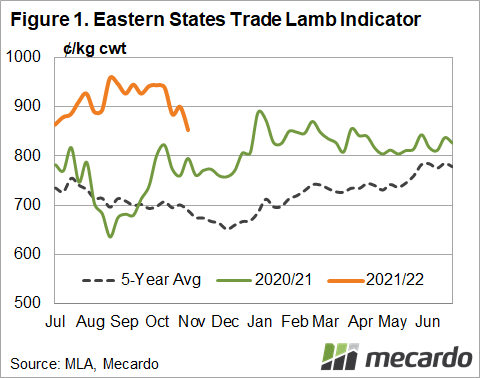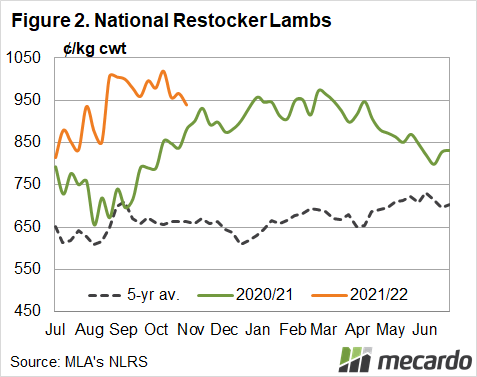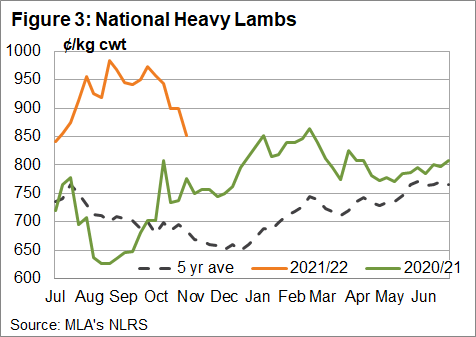We look at lamb prices each week, and the trend over the past couple has been heading south, as more suckers make it to market. However, regardless of what category your lambs currently fall in, if you're working off budget forecasts from 12 months ago, your returns should still be well ahead. In fact most indicators finished at their highest ever levels for this time of year last week.
As we can see on our first chart, the Eastern States Trade Lamb Indicator has been on the decline – not unusual for spring, but perhaps slightly earlier and more steeply than the five-year-average suggests is historically the norm. It has lost close to 100¢/kg in the past five weeks, to average 853¢/kg last week. But if you sell your suckers at roughly the same time each year, you’re still getting the best returns to date for the last week of October. The ESTLI is 7% higher than the same week last year – which was also then the highest it had ever been for that particular time – and it is also currently 20% above the five-year average.
The Restocker Lamb indicator is in much the same boat, trending downward earlier than the average, but still at its highest ever levels for the corresponding week. Despite losing 80¢/kg in just four weeks, having peaked at 1020¢/kg, last week’s 940¢/kg was also 7% above the equivalent period in 2020, and 30% higher than the five-year average. Heavy Lambs are even further ahead of the same time last year, up 9% to 851¢/kg, or 20% above the five-year average. It’s interesting to note that the Heavy Lamb indicator was at the same price last week as it was the opening week of trade for the year – which was its highest point until July.
Most recent supply data (from the week before last) saw lamb slaughter continue its yo-yo pattern over the past month or so, falling 21% below the five-year average. Numbers out of NSW have been firm, but pressure from increased supply in Victoria will have to be felt soon, especially if forecasts of October to December slaughter are to eventuate (read more about that here).
What does it mean?
When deciding if you should sell them or hold them, don’t be put off by the lamb price drop headlines – we know it comes around each year when sucker supply is abundant. If you do your sums on what your 20kg carcass weight new season lamb made last year compared to this, you will still be up more than $10/head. Restocker Lambs at about 16kg have seen the same jump, while heavy 24kg carcass weight lambs are now more than $15 dearer than last year.
That said, there’s little indication that usual prices rise won’t occur in the new year as per usual, although supply is expected to increase year-on-year, and land closer to the five-year average. But if you are going to hold them, you’d want to make sure you’ve got shearers locked in or seed isn’t an issue in your area.
Have any questions or comments?
Key Points
- Lamb prices have come off the boil, but are still historically high for mid-Spring.
- All key lamb indicators are tracking at their highest ever levels for this time of year, with returns up $10-$20/head.
- Surplus supply from Victoria will soon be felt, and throughput likely to rise next year.
Click on figure to expand
Click on figure to expand
Click on figure to expand
Data sources: MLA, Mecardo.




